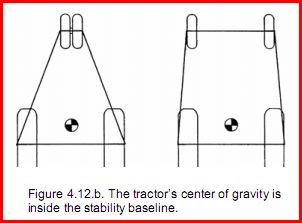vtsnowedin
Elite Member
Re: Tipped my BX25 FEL & BH on its side - what precautions to take before starting en
Do you really think a tractor can tip over without the low side front wheel coming to the limit of the front pivot play and at that point in time the upward resistance of the ground on that wheel is not applied as a reaction force upward times the distance that wheel is set out from the center of rotation?
Also do you really think that paper from that source got published without somebody really good at physics and statics checking the math?
People love their old tricycle front tractors for the nostalgia, and they were a great leap forward from what people were using before them, but stability was never their strong suit and we should all be glad they don't make them that way any more.
I hesitate to try this as it is like arguing evolution but...The premise that the lines define the tractors "stability baseline" is incorrect. It would hold true ONLY if you had a solid mounted front axle with absolutely no provision for it to pivot. To my knowledge, no tractor is built that way.

Do you really think a tractor can tip over without the low side front wheel coming to the limit of the front pivot play and at that point in time the upward resistance of the ground on that wheel is not applied as a reaction force upward times the distance that wheel is set out from the center of rotation?
Also do you really think that paper from that source got published without somebody really good at physics and statics checking the math?
People love their old tricycle front tractors for the nostalgia, and they were a great leap forward from what people were using before them, but stability was never their strong suit and we should all be glad they don't make them that way any more.